Taxation Law Assignment: ITAA 1997, GST, and Income Calculations
VerifiedAdded on 2020/03/28
|9
|1151
|84
Homework Assignment
AI Summary
This Taxation Law assignment solution addresses several key aspects of Australian taxation. It begins by identifying allowable deductions under section 8-1 of the ITAA 1997, including expenses related to machinery transfer, lawful proceedings, and solicitor expenditures, while excluding asset evaluations. The assignment then analyzes a case involving Big Bank Ltd and its GST obligations, differentiating between deductible and non-deductible advertising expenses. The solution also calculates Angelo's assessable income, considering foreign tax offsets. Finally, it presents a summary of Johnny and Leon's income. The document includes figures and references relevant legislation and scholarly articles, providing a comprehensive overview of the topics covered.
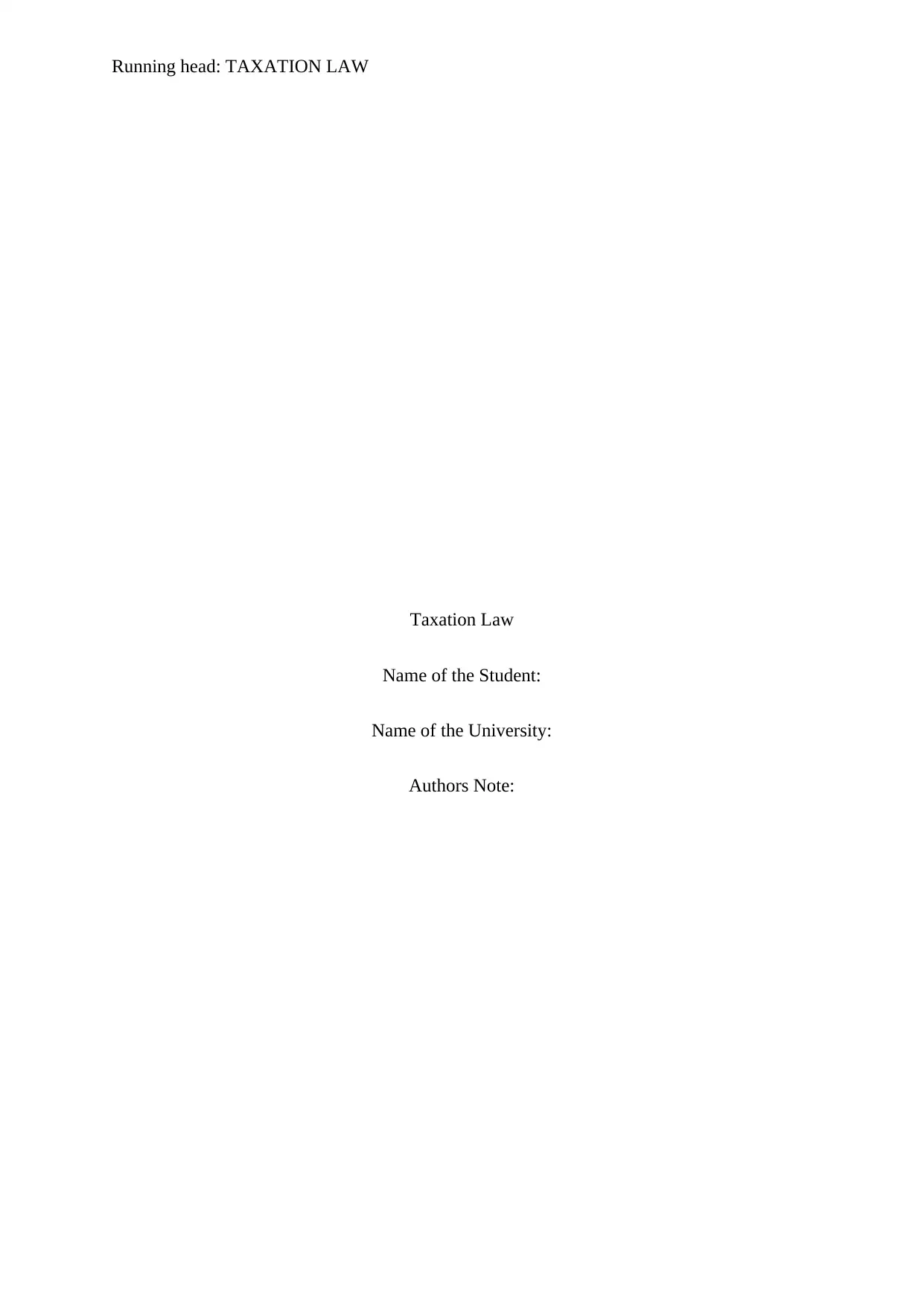
Running head: TAXATION LAW
Taxation Law
Name of the Student:
Name of the University:
Authors Note:
Taxation Law
Name of the Student:
Name of the University:
Authors Note:
Paraphrase This Document
Need a fresh take? Get an instant paraphrase of this document with our AI Paraphraser
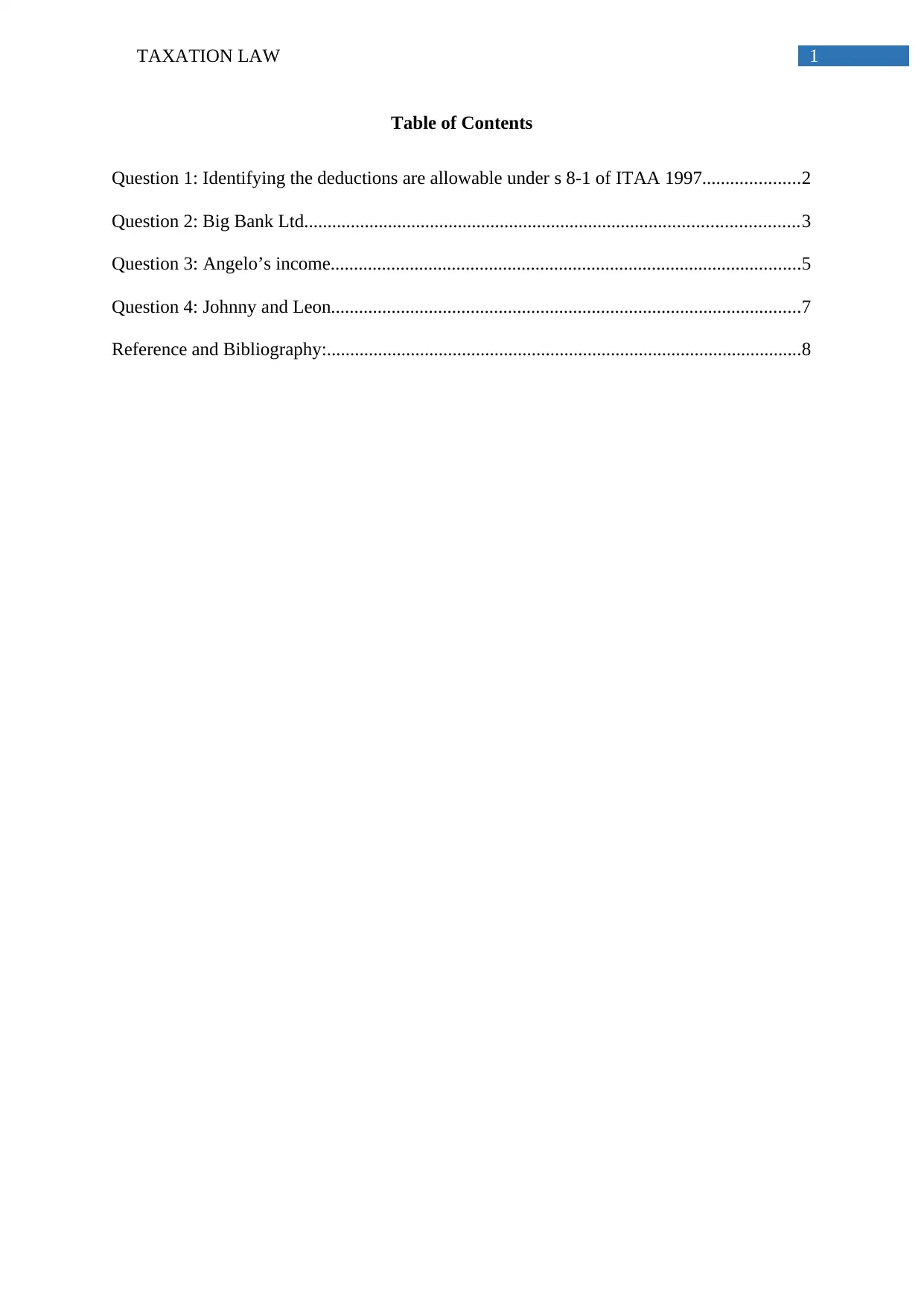
1TAXATION LAW
Table of Contents
Question 1: Identifying the deductions are allowable under s 8-1 of ITAA 1997.....................2
Question 2: Big Bank Ltd..........................................................................................................3
Question 3: Angelo’s income.....................................................................................................5
Question 4: Johnny and Leon.....................................................................................................7
Reference and Bibliography:......................................................................................................8
Table of Contents
Question 1: Identifying the deductions are allowable under s 8-1 of ITAA 1997.....................2
Question 2: Big Bank Ltd..........................................................................................................3
Question 3: Angelo’s income.....................................................................................................5
Question 4: Johnny and Leon.....................................................................................................7
Reference and Bibliography:......................................................................................................8
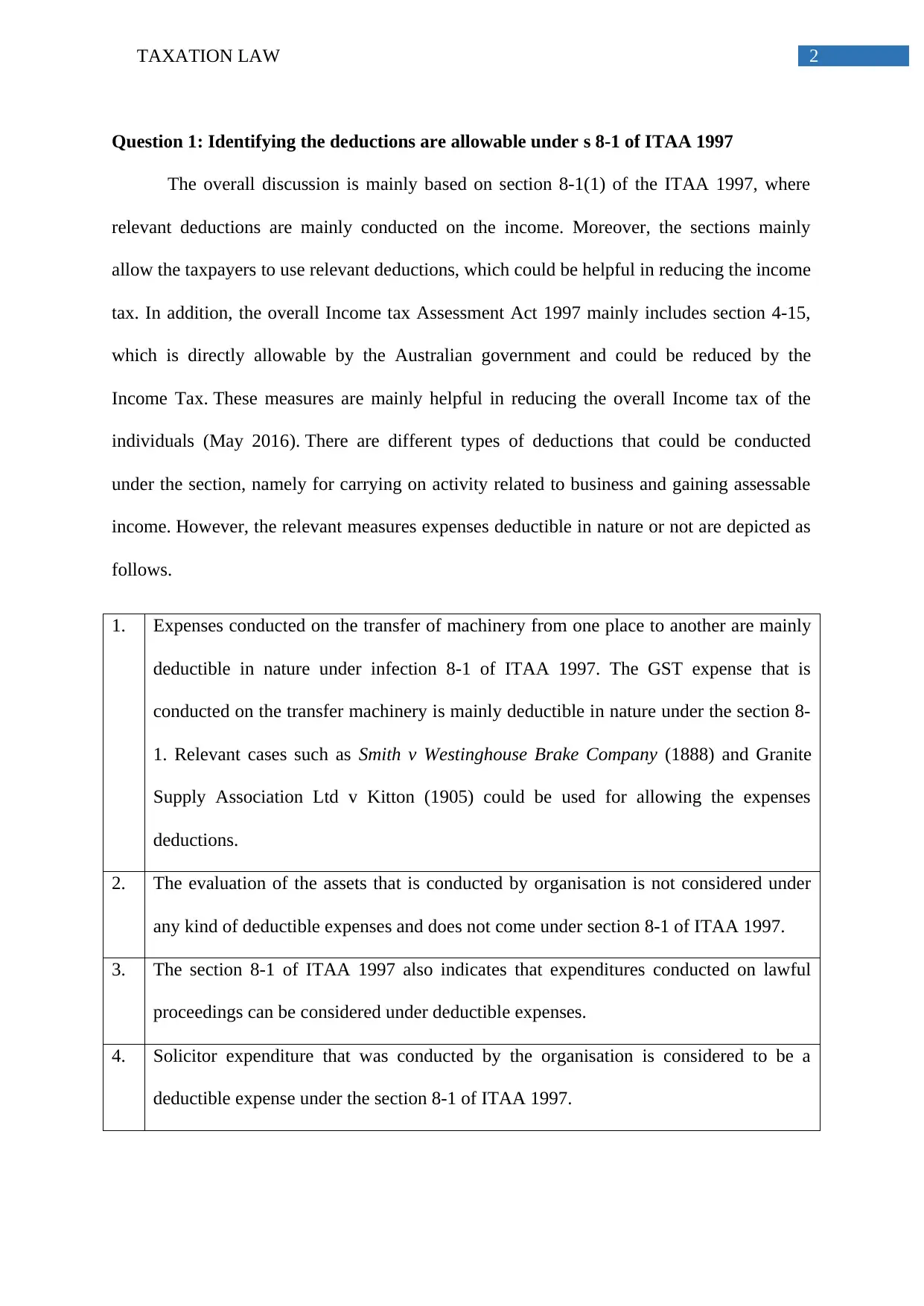
2TAXATION LAW
Question 1: Identifying the deductions are allowable under s 8-1 of ITAA 1997
The overall discussion is mainly based on section 8-1(1) of the ITAA 1997, where
relevant deductions are mainly conducted on the income. Moreover, the sections mainly
allow the taxpayers to use relevant deductions, which could be helpful in reducing the income
tax. In addition, the overall Income tax Assessment Act 1997 mainly includes section 4-15,
which is directly allowable by the Australian government and could be reduced by the
Income Tax. These measures are mainly helpful in reducing the overall Income tax of the
individuals (May 2016). There are different types of deductions that could be conducted
under the section, namely for carrying on activity related to business and gaining assessable
income. However, the relevant measures expenses deductible in nature or not are depicted as
follows.
1. Expenses conducted on the transfer of machinery from one place to another are mainly
deductible in nature under infection 8-1 of ITAA 1997. The GST expense that is
conducted on the transfer machinery is mainly deductible in nature under the section 8-
1. Relevant cases such as Smith v Westinghouse Brake Company (1888) and Granite
Supply Association Ltd v Kitton (1905) could be used for allowing the expenses
deductions.
2. The evaluation of the assets that is conducted by organisation is not considered under
any kind of deductible expenses and does not come under section 8-1 of ITAA 1997.
3. The section 8-1 of ITAA 1997 also indicates that expenditures conducted on lawful
proceedings can be considered under deductible expenses.
4. Solicitor expenditure that was conducted by the organisation is considered to be a
deductible expense under the section 8-1 of ITAA 1997.
Question 1: Identifying the deductions are allowable under s 8-1 of ITAA 1997
The overall discussion is mainly based on section 8-1(1) of the ITAA 1997, where
relevant deductions are mainly conducted on the income. Moreover, the sections mainly
allow the taxpayers to use relevant deductions, which could be helpful in reducing the income
tax. In addition, the overall Income tax Assessment Act 1997 mainly includes section 4-15,
which is directly allowable by the Australian government and could be reduced by the
Income Tax. These measures are mainly helpful in reducing the overall Income tax of the
individuals (May 2016). There are different types of deductions that could be conducted
under the section, namely for carrying on activity related to business and gaining assessable
income. However, the relevant measures expenses deductible in nature or not are depicted as
follows.
1. Expenses conducted on the transfer of machinery from one place to another are mainly
deductible in nature under infection 8-1 of ITAA 1997. The GST expense that is
conducted on the transfer machinery is mainly deductible in nature under the section 8-
1. Relevant cases such as Smith v Westinghouse Brake Company (1888) and Granite
Supply Association Ltd v Kitton (1905) could be used for allowing the expenses
deductions.
2. The evaluation of the assets that is conducted by organisation is not considered under
any kind of deductible expenses and does not come under section 8-1 of ITAA 1997.
3. The section 8-1 of ITAA 1997 also indicates that expenditures conducted on lawful
proceedings can be considered under deductible expenses.
4. Solicitor expenditure that was conducted by the organisation is considered to be a
deductible expense under the section 8-1 of ITAA 1997.
⊘ This is a preview!⊘
Do you want full access?
Subscribe today to unlock all pages.

Trusted by 1+ million students worldwide
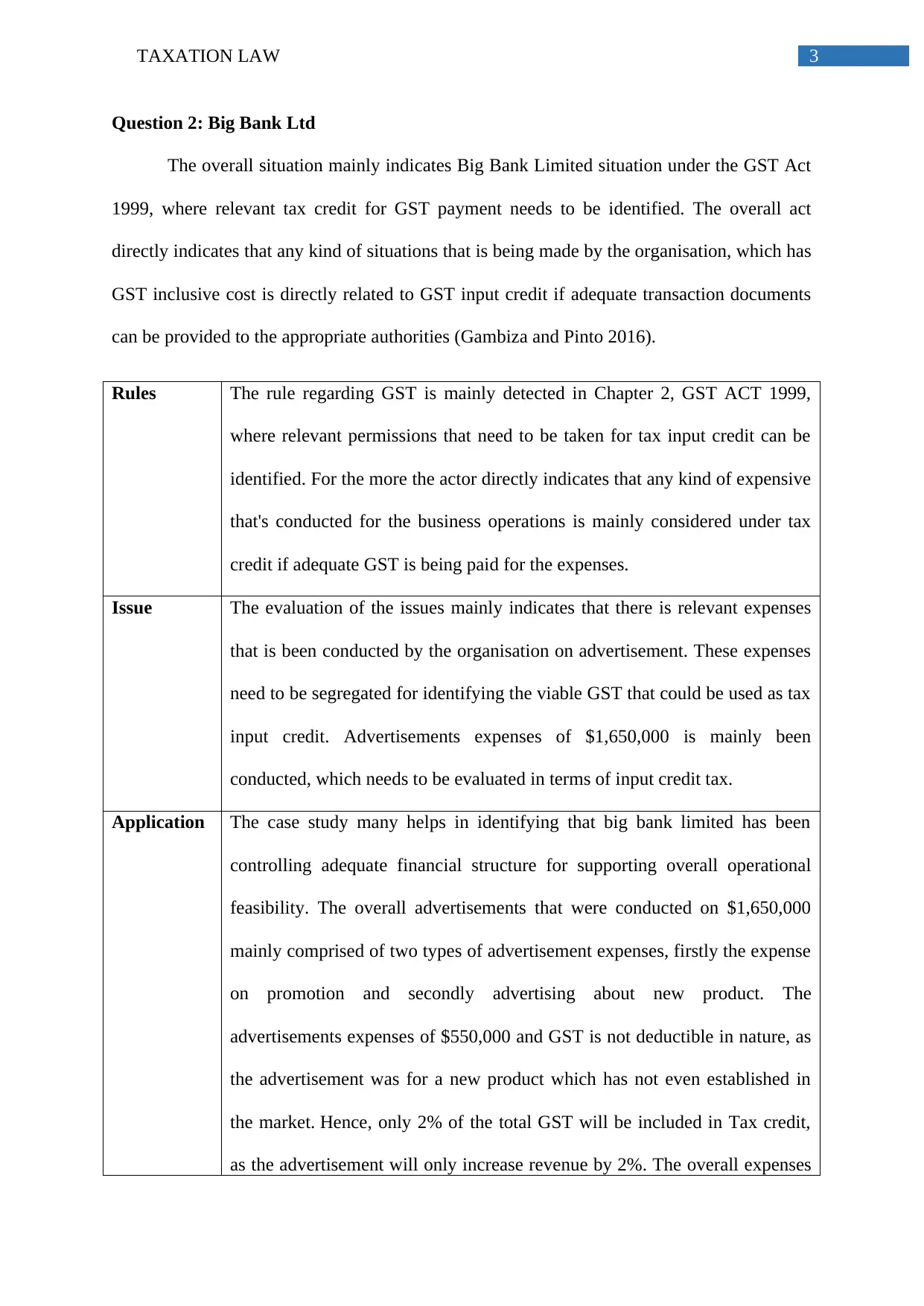
3TAXATION LAW
Question 2: Big Bank Ltd
The overall situation mainly indicates Big Bank Limited situation under the GST Act
1999, where relevant tax credit for GST payment needs to be identified. The overall act
directly indicates that any kind of situations that is being made by the organisation, which has
GST inclusive cost is directly related to GST input credit if adequate transaction documents
can be provided to the appropriate authorities (Gambiza and Pinto 2016).
Rules The rule regarding GST is mainly detected in Chapter 2, GST ACT 1999,
where relevant permissions that need to be taken for tax input credit can be
identified. For the more the actor directly indicates that any kind of expensive
that's conducted for the business operations is mainly considered under tax
credit if adequate GST is being paid for the expenses.
Issue The evaluation of the issues mainly indicates that there is relevant expenses
that is been conducted by the organisation on advertisement. These expenses
need to be segregated for identifying the viable GST that could be used as tax
input credit. Advertisements expenses of $1,650,000 is mainly been
conducted, which needs to be evaluated in terms of input credit tax.
Application The case study many helps in identifying that big bank limited has been
controlling adequate financial structure for supporting overall operational
feasibility. The overall advertisements that were conducted on $1,650,000
mainly comprised of two types of advertisement expenses, firstly the expense
on promotion and secondly advertising about new product. The
advertisements expenses of $550,000 and GST is not deductible in nature, as
the advertisement was for a new product which has not even established in
the market. Hence, only 2% of the total GST will be included in Tax credit,
as the advertisement will only increase revenue by 2%. The overall expenses
Question 2: Big Bank Ltd
The overall situation mainly indicates Big Bank Limited situation under the GST Act
1999, where relevant tax credit for GST payment needs to be identified. The overall act
directly indicates that any kind of situations that is being made by the organisation, which has
GST inclusive cost is directly related to GST input credit if adequate transaction documents
can be provided to the appropriate authorities (Gambiza and Pinto 2016).
Rules The rule regarding GST is mainly detected in Chapter 2, GST ACT 1999,
where relevant permissions that need to be taken for tax input credit can be
identified. For the more the actor directly indicates that any kind of expensive
that's conducted for the business operations is mainly considered under tax
credit if adequate GST is being paid for the expenses.
Issue The evaluation of the issues mainly indicates that there is relevant expenses
that is been conducted by the organisation on advertisement. These expenses
need to be segregated for identifying the viable GST that could be used as tax
input credit. Advertisements expenses of $1,650,000 is mainly been
conducted, which needs to be evaluated in terms of input credit tax.
Application The case study many helps in identifying that big bank limited has been
controlling adequate financial structure for supporting overall operational
feasibility. The overall advertisements that were conducted on $1,650,000
mainly comprised of two types of advertisement expenses, firstly the expense
on promotion and secondly advertising about new product. The
advertisements expenses of $550,000 and GST is not deductible in nature, as
the advertisement was for a new product which has not even established in
the market. Hence, only 2% of the total GST will be included in Tax credit,
as the advertisement will only increase revenue by 2%. The overall expenses
Paraphrase This Document
Need a fresh take? Get an instant paraphrase of this document with our AI Paraphraser
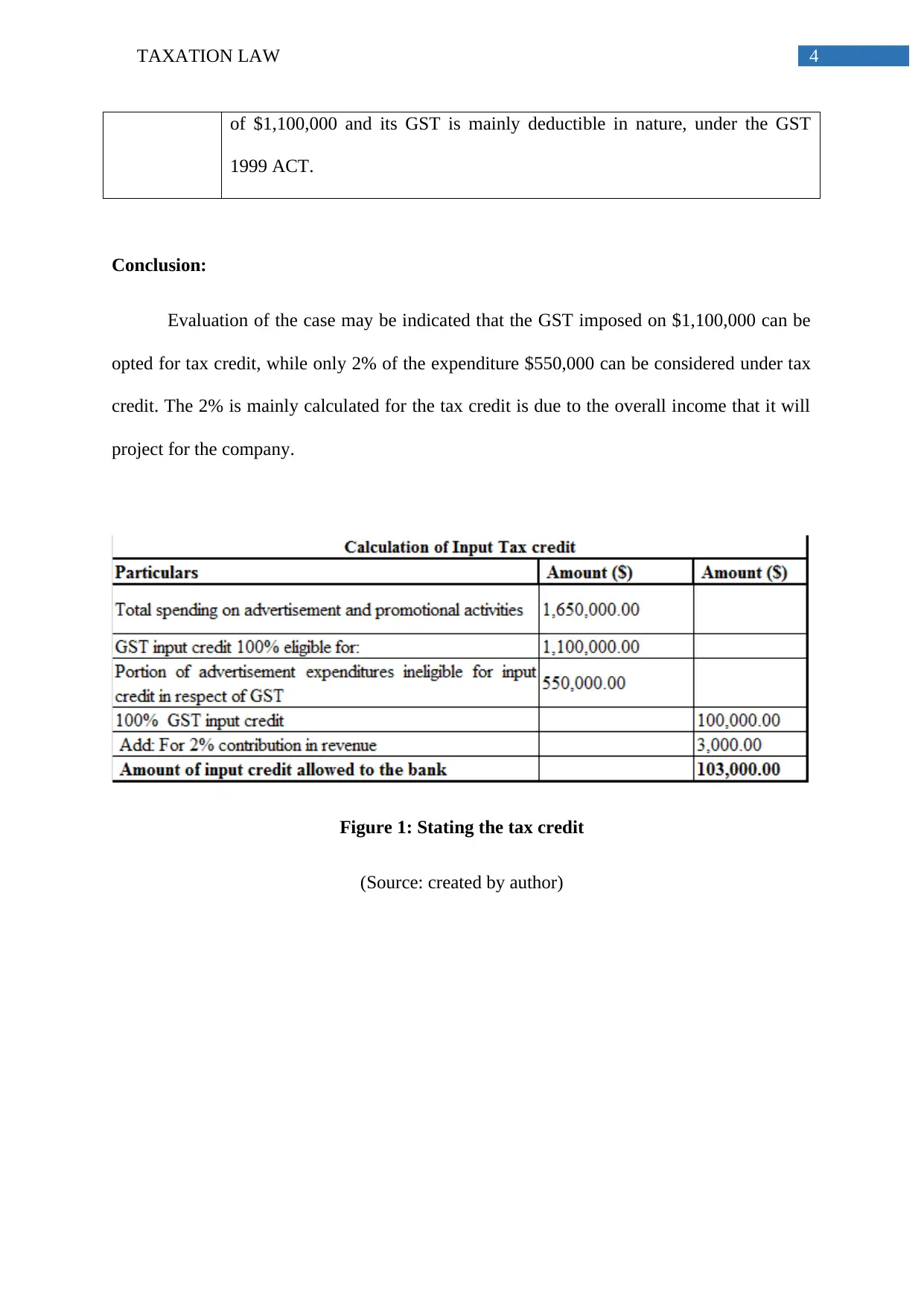
4TAXATION LAW
of $1,100,000 and its GST is mainly deductible in nature, under the GST
1999 ACT.
Conclusion:
Evaluation of the case may be indicated that the GST imposed on $1,100,000 can be
opted for tax credit, while only 2% of the expenditure $550,000 can be considered under tax
credit. The 2% is mainly calculated for the tax credit is due to the overall income that it will
project for the company.
Figure 1: Stating the tax credit
(Source: created by author)
of $1,100,000 and its GST is mainly deductible in nature, under the GST
1999 ACT.
Conclusion:
Evaluation of the case may be indicated that the GST imposed on $1,100,000 can be
opted for tax credit, while only 2% of the expenditure $550,000 can be considered under tax
credit. The 2% is mainly calculated for the tax credit is due to the overall income that it will
project for the company.
Figure 1: Stating the tax credit
(Source: created by author)
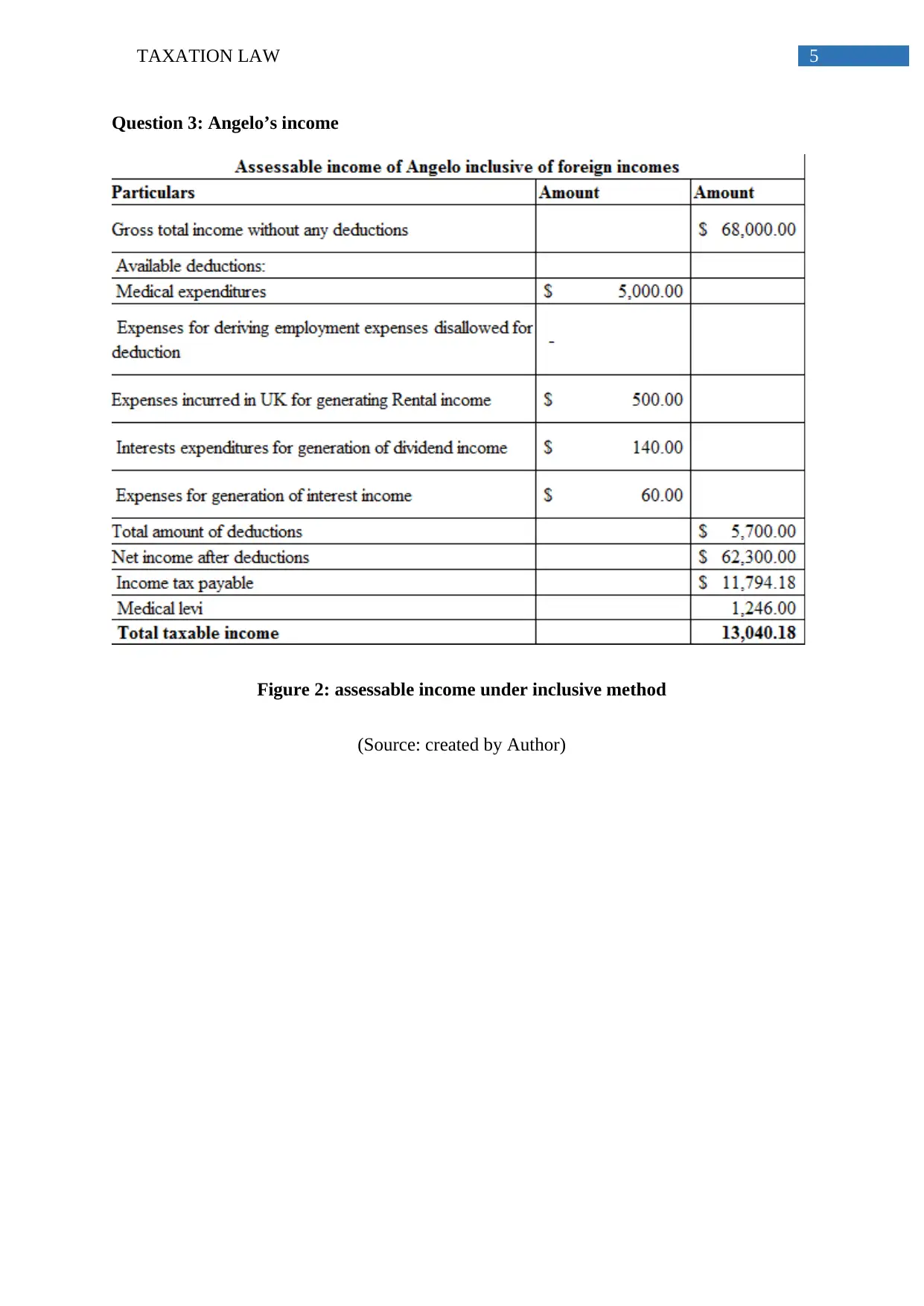
5TAXATION LAW
Question 3: Angelo’s income
Figure 2: assessable income under inclusive method
(Source: created by Author)
Question 3: Angelo’s income
Figure 2: assessable income under inclusive method
(Source: created by Author)
⊘ This is a preview!⊘
Do you want full access?
Subscribe today to unlock all pages.

Trusted by 1+ million students worldwide
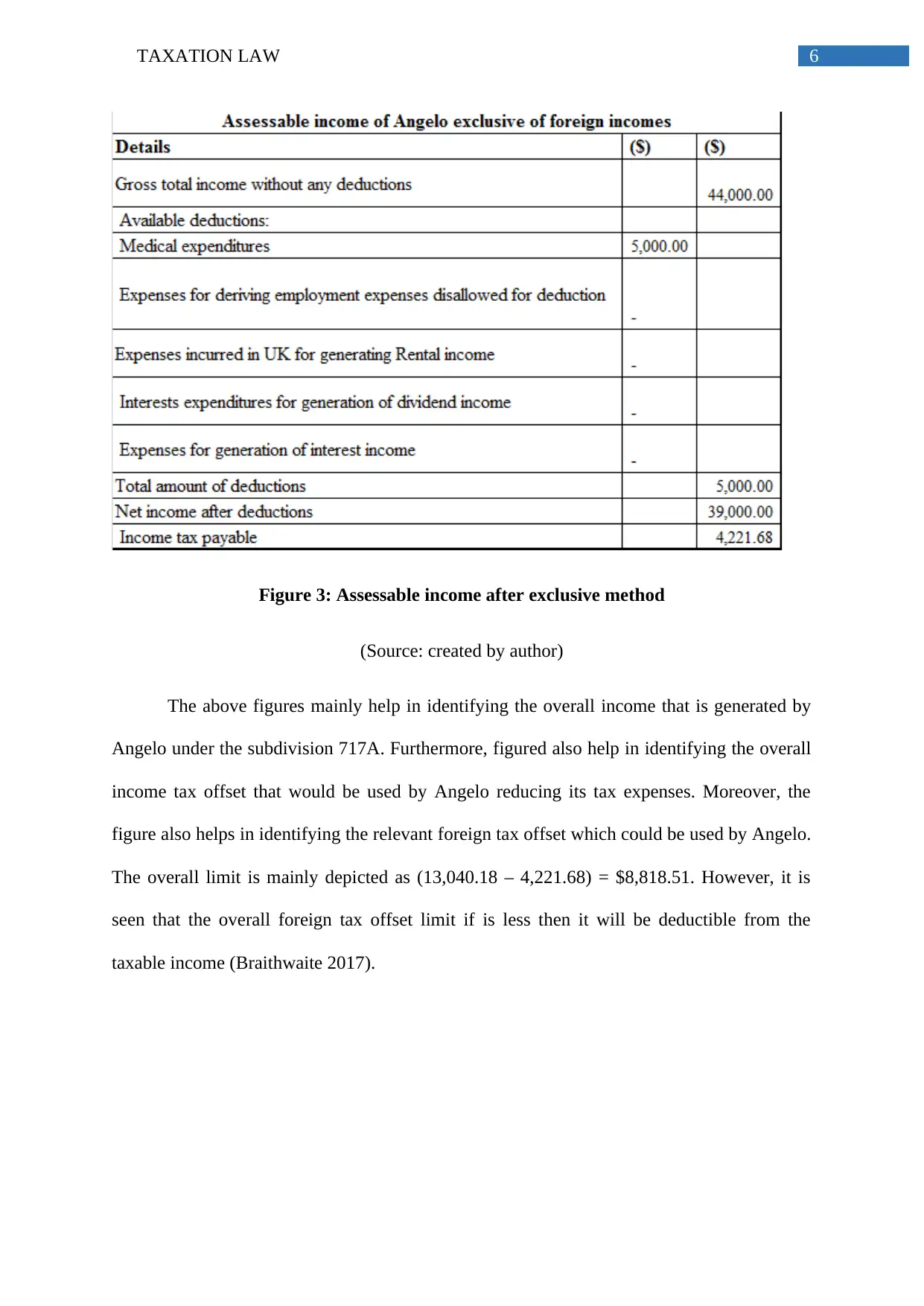
6TAXATION LAW
Figure 3: Assessable income after exclusive method
(Source: created by author)
The above figures mainly help in identifying the overall income that is generated by
Angelo under the subdivision 717A. Furthermore, figured also help in identifying the overall
income tax offset that would be used by Angelo reducing its tax expenses. Moreover, the
figure also helps in identifying the relevant foreign tax offset which could be used by Angelo.
The overall limit is mainly depicted as (13,040.18 – 4,221.68) = $8,818.51. However, it is
seen that the overall foreign tax offset limit if is less then it will be deductible from the
taxable income (Braithwaite 2017).
Figure 3: Assessable income after exclusive method
(Source: created by author)
The above figures mainly help in identifying the overall income that is generated by
Angelo under the subdivision 717A. Furthermore, figured also help in identifying the overall
income tax offset that would be used by Angelo reducing its tax expenses. Moreover, the
figure also helps in identifying the relevant foreign tax offset which could be used by Angelo.
The overall limit is mainly depicted as (13,040.18 – 4,221.68) = $8,818.51. However, it is
seen that the overall foreign tax offset limit if is less then it will be deductible from the
taxable income (Braithwaite 2017).
Paraphrase This Document
Need a fresh take? Get an instant paraphrase of this document with our AI Paraphraser
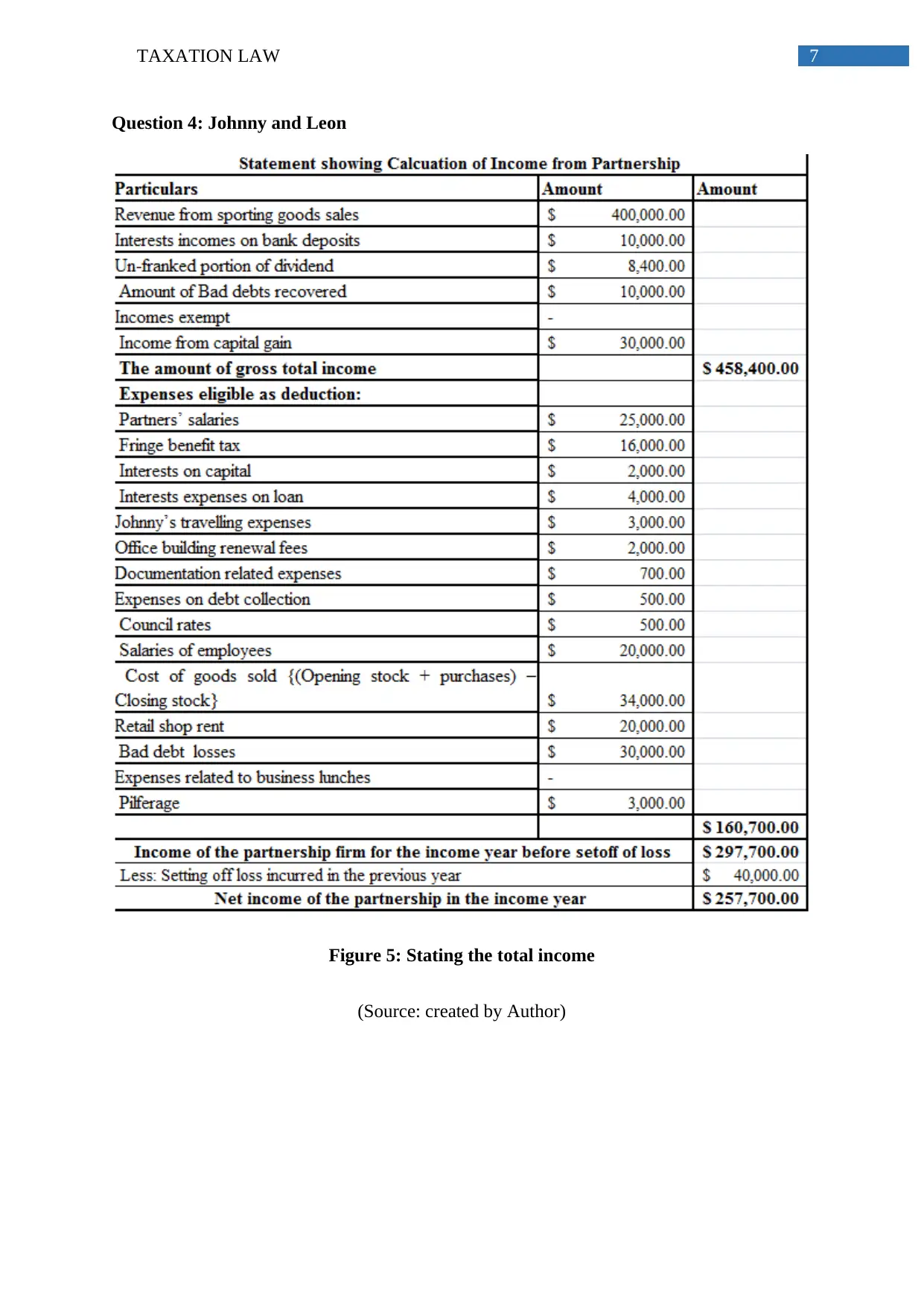
7TAXATION LAW
Question 4: Johnny and Leon
Figure 5: Stating the total income
(Source: created by Author)
Question 4: Johnny and Leon
Figure 5: Stating the total income
(Source: created by Author)
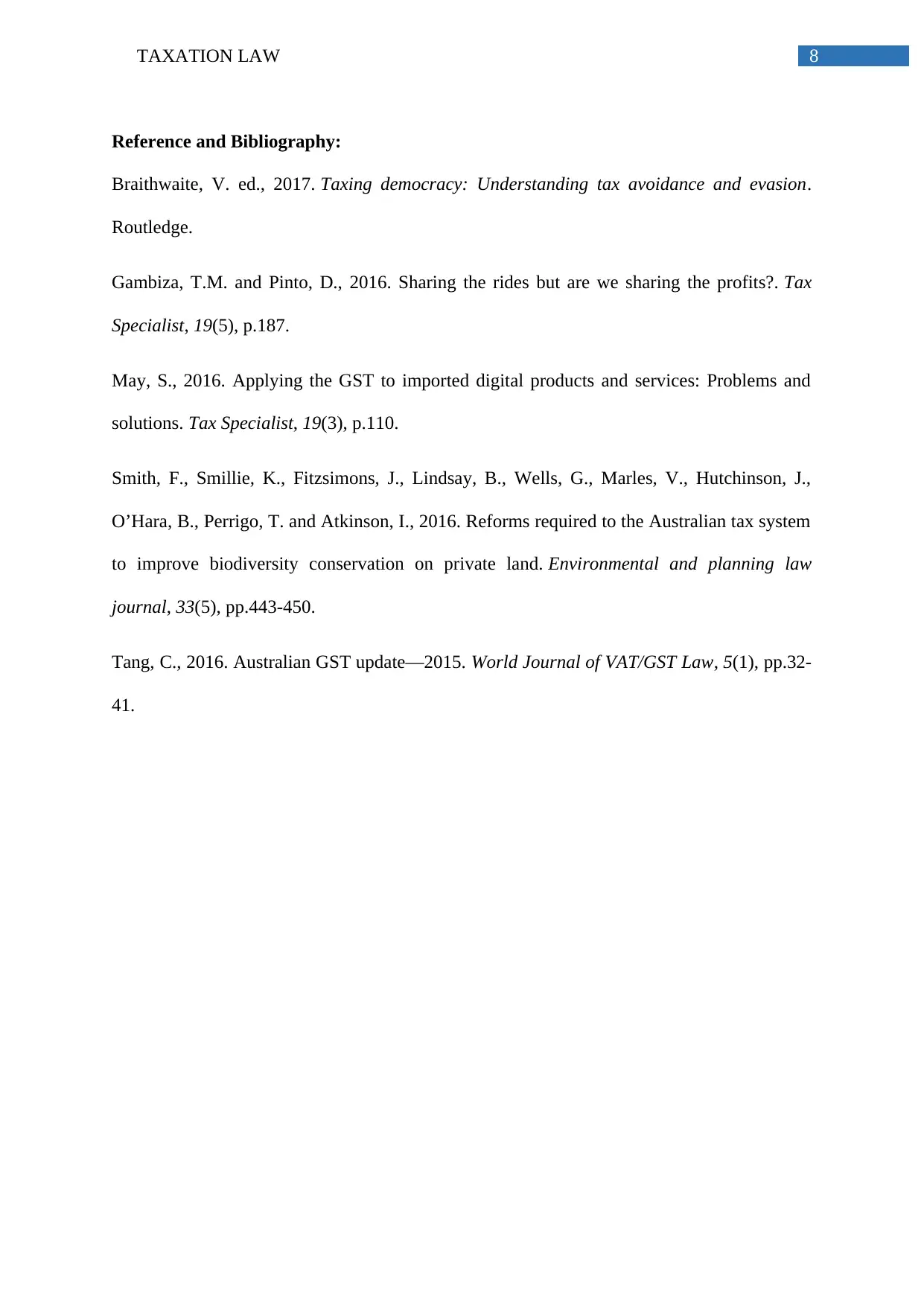
8TAXATION LAW
Reference and Bibliography:
Braithwaite, V. ed., 2017. Taxing democracy: Understanding tax avoidance and evasion.
Routledge.
Gambiza, T.M. and Pinto, D., 2016. Sharing the rides but are we sharing the profits?. Tax
Specialist, 19(5), p.187.
May, S., 2016. Applying the GST to imported digital products and services: Problems and
solutions. Tax Specialist, 19(3), p.110.
Smith, F., Smillie, K., Fitzsimons, J., Lindsay, B., Wells, G., Marles, V., Hutchinson, J.,
O’Hara, B., Perrigo, T. and Atkinson, I., 2016. Reforms required to the Australian tax system
to improve biodiversity conservation on private land. Environmental and planning law
journal, 33(5), pp.443-450.
Tang, C., 2016. Australian GST update—2015. World Journal of VAT/GST Law, 5(1), pp.32-
41.
Reference and Bibliography:
Braithwaite, V. ed., 2017. Taxing democracy: Understanding tax avoidance and evasion.
Routledge.
Gambiza, T.M. and Pinto, D., 2016. Sharing the rides but are we sharing the profits?. Tax
Specialist, 19(5), p.187.
May, S., 2016. Applying the GST to imported digital products and services: Problems and
solutions. Tax Specialist, 19(3), p.110.
Smith, F., Smillie, K., Fitzsimons, J., Lindsay, B., Wells, G., Marles, V., Hutchinson, J.,
O’Hara, B., Perrigo, T. and Atkinson, I., 2016. Reforms required to the Australian tax system
to improve biodiversity conservation on private land. Environmental and planning law
journal, 33(5), pp.443-450.
Tang, C., 2016. Australian GST update—2015. World Journal of VAT/GST Law, 5(1), pp.32-
41.
⊘ This is a preview!⊘
Do you want full access?
Subscribe today to unlock all pages.

Trusted by 1+ million students worldwide
1 out of 9
Related Documents
Your All-in-One AI-Powered Toolkit for Academic Success.
+13062052269
info@desklib.com
Available 24*7 on WhatsApp / Email
![[object Object]](/_next/static/media/star-bottom.7253800d.svg)
Unlock your academic potential
Copyright © 2020–2025 A2Z Services. All Rights Reserved. Developed and managed by ZUCOL.





